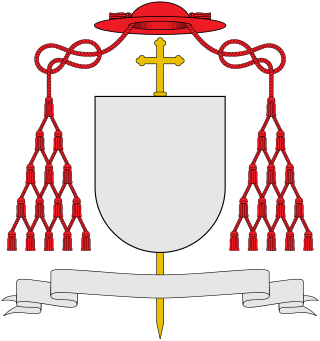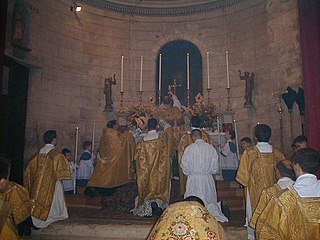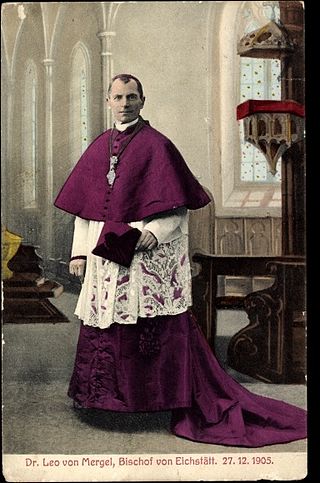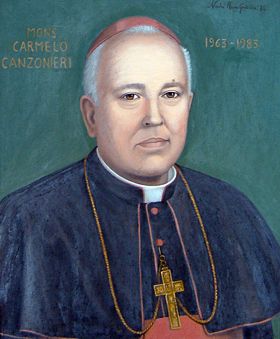
A cardinal is a senior member of the clergy of the Catholic Church. Cardinals are created by the pope and typically hold the title for life. Collectively, they constitute the College of Cardinals.

The cassock or soutane is a Christian clerical clothing coat used by the clergy and male religious of the Oriental Orthodox Churches, Eastern Orthodox Church and the Catholic Church, in addition to some clergy in certain Protestant denominations such as Anglicans and Lutherans. "Ankle-length garment" is the literal meaning of the corresponding Latin term, vestis talaris. It is related to the habits traditionally worn by nuns, monks, and friars.

Vestments are liturgical garments and articles associated primarily with the Christian religion, especially by Eastern Churches, Catholics, Lutherans, and Anglicans. Many other groups also make use of liturgical garments; among the Reformed (Calvinist) Churches this was a point of controversy in the Protestant Reformation and sometimes since, in particular during the Anglican ritualist controversies in England in the 19th century.

The mitre or miter is a type of headgear now known as the traditional, ceremonial headdress of bishops and certain abbots in traditional Christianity. Mitres are worn in the Catholic Church, Eastern Orthodox Church, Oriental Orthodox Churches, the Anglican Communion, some Lutheran churches, for important ceremonies, by the Metropolitan of the Malankara Mar Thoma Syrian Church, and also, in the Catholic Church, all cardinals, whether or not bishops, and some Eastern Orthodox archpriests.

The biretta is a square cap with three or four peaks or horns, sometimes surmounted by a tuft. Traditionally the three-peaked biretta is worn by Christian clergy, especially Roman Catholic clergy, as well as some Lutheran and Anglican clergy. A four-peaked biretta is worn as academic dress by those holding a doctoral degree from a pontifical faculty or pontifical university or faculty. Occasionally the biretta is worn by advocates in law courts, for instance the advocates in the Channel Islands.

The zucchetto or solideo, officially a pileolus, is a small, hemispherical, form-fitting ecclesiastical skullcap worn by clerics of various Catholic churches, the Syriac Orthodox Church, and by senior clergy in Anglicanism.

The cope is a liturgical vestment, more precisely a long mantle or cloak, open in front and fastened at the breast with a band or clasp. It may be of any liturgical colour.

Monsignor is a form of address or title for certain members of the clergy in the Catholic Church. Monsignor is the apocopic form of the Italian monsignore, meaning "my lord". "Monsignor" can be abbreviated as Mons. or Msgr. In some countries, the title "monsignor" is used as a form of address for bishops. However, in English-speaking countries, the title is unrelated to the episcopacy, though many priests with the title later become bishops.

A galero is a broad-brimmed hat with tasselated strings which was worn by clergy in the Catholic Church. Over the centuries, the red galero was restricted to use by individual cardinals while such other colors as black, green and violet were reserved to clergy of other ranks and styles.

Papal regalia and insignia are the official items of attire and decoration proper to the Pope in his capacity as the visible head of the Catholic Church and sovereign of the Vatican City State.

The Ring of the Fisherman, also known as the Piscatory Ring, is an official part of the regalia worn by the pope, who according to Catholic theology is the head of the Catholic Church and successor of Saint Peter, who was a fisherman by trade. It used to feature a bas-relief of Peter fishing from a boat, a symbolism derived from the tradition that the apostles were "fishers of men". The Fisherman's Ring is a signet used until 1842 to seal official documents signed by the pope. Since at least the Middle Ages it has been a tradition for Catholics meeting the pope to show their devotion by kissing the ring.

A camauro is a cap traditionally worn by the pope, the head of the Catholic Church.
Clerical clothing is non-liturgical clothing worn exclusively by clergy. It is distinct from vestments in that it is not reserved specifically for use in the liturgy. Practices vary: clerical clothing is sometimes worn under vestments, and sometimes as the everyday clothing or street wear of a priest, minister, or other clergy member. In some cases, it can be similar or identical to the habit of a monk or nun.

Choir dress is the traditional vesture of the clerics, seminarians and religious of Christian churches worn for public prayer and the administration of the sacraments except when celebrating or concelebrating the Eucharist. It differs from the vestments worn by the celebrants of the Eucharist, being normally made of fabrics such as wool, cotton or silk, as opposed to the fine brocades used in vestments. It may also be worn by lay assistants such as acolytes and choirs. It was abandoned by most of the Protestant churches that developed from the sixteenth-century Reformation.

The mozzetta is a short elbow-length sartorial vestment, a cape that covers the shoulders and is buttoned over the frontal breast area. It is worn over the rochet or cotta as part of choir dress by some of the clergy of the Catholic Church, among them the pope, cardinals, bishops, abbots, canons and religious superiors. There used to be a small hood on the back of the mozzetta of bishops and cardinals, but this was discontinued by Pope Paul VI. The hood, however, was retained in the mozzette of certain canons and abbots, and in that of the popes, often trimmed in satin, silk or ermine material.

Ecclesiastical heraldry refers to the use of heraldry within Christianity for dioceses, organisations and Christian clergy. Initially used to mark documents, ecclesiastical heraldry evolved as a system for identifying people and dioceses. It is most formalized within the Catholic Church, where most bishops, including the Pope, have a personal coat of arms. Clergy in Anglican, Lutheran, Eastern Catholic and Eastern Orthodox churches follow similar customs, as do institutions such as schools and dioceses.

The fascia is a sash worn by clerics and seminarians with the cassock in the Roman Catholic Church and in the Anglican Church. It is not worn as a belt but is placed above the waist between the navel and the breastbone (sternum). The ends that hang down are worn on the left side of the body and placed a little forward but not completely off the left hip.
Religious clothing is clothing which is worn in accordance with religious practice, tradition or significance to a faith group. It includes clerical clothing such as cassocks, and religious habit, robes, and other vestments. Accessories include hats, wedding rings, crucifixes, etc.

The ceremonial of Benedict XVI (2005–2013) re-introduced several papal garments which had previously fallen into disuse.

The pellegrina is a cape-like item of clerical dress worn by some Catholic ecclesiastics.























